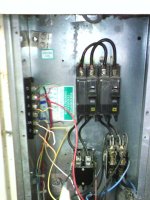Thinking out loud, little bit of guessing here: Below the breakers on the right is a standard contractor. It has a capacitor on it, so it could be running a fan or compressor. Also coming off that breaker is a small set of wires that probably goto the transformer (24V) for the unit. Now on the left side, we see that breaker going into some device, and there are no clear wires coming off of it but you can see a brown and black small wire. These probably turn the device on. You might want to check and see if this somehow goes to the resistive electric strips. Sometimes the strips use a special contractor that makes a first contact with one set of resistive strips, and a few seconds later makes contact with the 2nd strip. This breaks up the inrush current from cold strips.
If this is true, then look at the size of the wire look on the top of the breakers. It looks bigger than the wires going down to the contactor and time delay contactor. So I'm _guessing_ that the resistive electric strips and the compressor are on their own breakers and the wire loops are used so there can be one feed. That way you could feed the entire unit with a (for example, don't know the real numbers) 60 amp feed, and have a 10 KW (40A) resistive strip and a 1.5 ton compressor. If you had a single 60 amp breaker, it might be oversized to protect the compressor. So you take one power feed and break it up with two breakers that are matched for the devices they connect to.
My geothermal units use separate feeds for the resistive strips and the rest of the system so that the breakers are matched to their respective devices. I like the separate feeds because I can put the resistive electric strips before my generator transfer switch, and run the rest of the heat pump on the generator. This lets me get by with a smaller generator.
I want to stress that these are guesses that can be used to help you further trace the wiring to figure out what's going on. You will need to verify the exact way this is wired, and the correct size for the circuits. Hope this makes sense.
Pete
